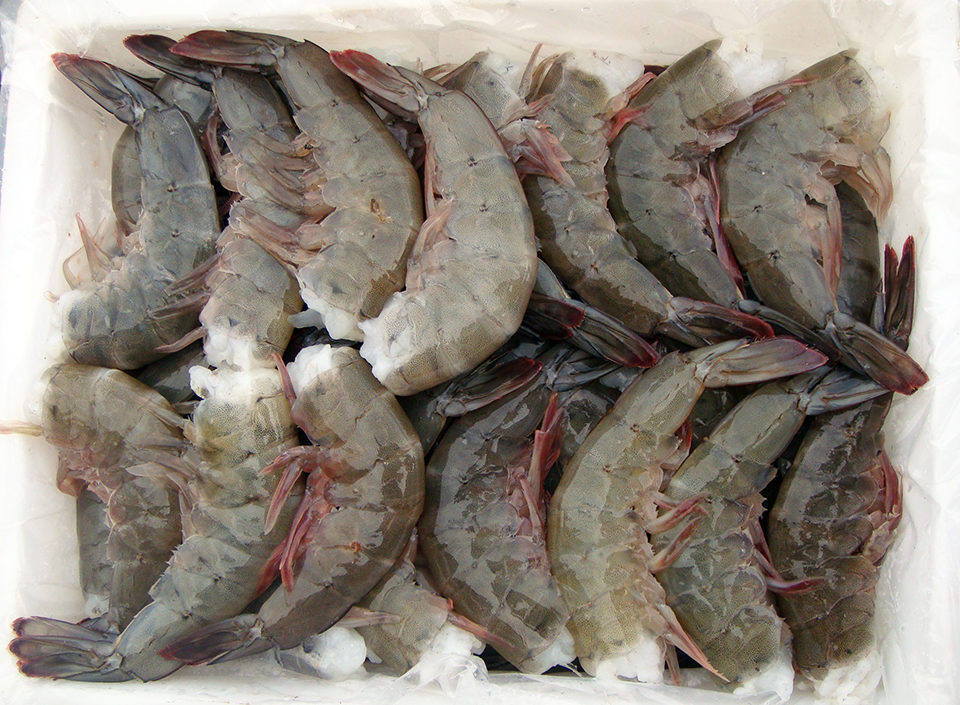When selecting for the two traits, responses for body weight and yield were similar

Shrimp market prices are based on body weight, although one of the main commercialization forms is based on shrimp tail weight, such that the tail is the main component of the processed shrimp. Hence, it is important to evaluate the feasibility of incorporating the tail weight and yield (proportion of the total body weight represented by the tail weight) in breeding programs with the aim of increasing farmers’ profitability.
Selection criteria
Breeding programs for Pacific white shrimp (Litopenaeus vannamei) have been focused on improving growth traits, survival and resistance to specific diseases. That is why selection criteria are usually defined to obtain a high commercial value biomass – producing a large number of shrimp with high individual body weights. Tail weight, yield and their association with body weight are usually not considered.
When considering a selection criterion for a breeding program, it is important to first answer these questions: Can the criterion be measured in the selection candidate or its relatives? Is it heritable and related to the breeding objective? Does the trait show genetic variation? Is it profitable to measure it?
With the aim of answering these questions in relation to the possible inclusion of yield tail weight in the breeding program of Maricultura del Pacifico, the largest penaeid shrimp hatchery in Mexico, the authors carried out a study designed to estimate heritabilities for body weight, tail weight and yield at 130 days of age, as well as their genetic correlations.
Study setup
To estimate genetic parameters, 8,208 body weight, tail weight and yield records from 2010 for 150 families were otained from the Maricultura del Pacífico hatchery breeding program. The analysis considered a nine-generation pedigree file for 2002 to 2010. Additionally, the body weight and yield relative economic values were obtained from a profit equation using Mexican shrimp market prices.
To evaluate the potential advantage of incorporating yield in the economic response for this population, the economic response was compared with a selection index based on these economic values that involved body weight and yield, with another that involved body weight only.
Results
The means and standard deviations were 15.4 ± 2.6 grams for body weight, 9.6 ± 1.6 grams for tail weight and 61.9 ± 1.8 percent for yield. The genetic correlation between body weight and tail weight was essentially 1, which implied that in practical terms, they are the same trait. Hence, the decision about which trait to include in the breeding program depends on the cost of measuring the traits. In this case, obtaining the tail weight implies added labor, increased costs and, in some breeding schemes, the loss of evaluated animals as potential breeding candidates.
Yield has a smaller genetic variation than body weight. Moreover, the genetic correlations between yield and body weight (0.30), and between yield and tail weight (0.48) were not statistically significant.
When comparing the economic response per generation for family selection using an index that consideredbody weight and yield with relative weights of 35 grams and 8.5 Mexican pesos, respectively, with that obtained with an index that considered only the body weight, the response for the index with both traits was 17.2 Mexican pesos, compared to 17.0 Mexican pesos for an index that considered only body weight. When selecting for the two traits, the responses for body weight and yield were similar in both cases: 0.49 grams and 0.01 percent, respectively.
Perspectives
The authors concluded that it is not necessary to include tail weight as an additional trait or to replace body weight with it in Pacific white shrimp-breeding programs because measuring either of the two traits led to a similar result.
Although including yield in addition to body weight in selection indices appears to increase the economic response to selection, the expected economic response if yield is ignored is 99 percent of that obtained using both traits. This is due mainly to the smaller genetic variation of yield, but also to its lower economic value when compared to that of body weight.
(Editor’s Note: This article was originally published in the November/December 2011 print edition of the Global Aquaculture Advocate.)
Authors
-
Dr. Gabriel Campos-Montes
Departamento El Hombre y su Ambiente
Universidad Autónoma Metropolitana – Unidad Xochimilco
Calzada del Hueso 1100, Col. Villa
Quietud, Delegación Coyoacán, C. P.
04960 México, D. F. -
Dr. Hugo H. Montaldo
Universidad Nacional Autónoma de México
Ciudad Universitaria, México -
Dr. Alfonso Martínez Ortega
Maricultura del Pacífico S.A. de C.V.
Mazatlán, Sinaloa, México -
Dr. Héctor Castillo-Juárez
Departamento Ciencias Agropecuarias
Universidad Autónoma Metropolitana – Unidad Xochimilco
Tagged With
Related Posts

Responsibility
A look at integrated multi-trophic aquaculture
In integrated multi-trophic aquaculture, farmers combine the cultivation of fed species such as finfish or shrimp with extractive seaweeds, aquatic plants and shellfish and other invertebrates that recapture organic and inorganic particulate nutrients for their growth.

Aquafeeds
A look at phospholipids in aquafeeds
Phospholipids are the major constituents of cell membranes and are vital to the normal function of every cell and organ. The inclusion of phospholipids in aquafeeds ensures increased growth, better survival and stress resistance, and prevention of skeletal deformities of larval and juvenile stages of fish and shellfish species.

Aquafeeds
Animal byproduct concentrates useful tools in formulation
With the market volatility of fishmeal, as well as rising sustainability concerns, the aquaculture industry is seeking sources of protein, such as animal byproduct concentrates, to substitute for fishmeal.

Aquafeeds
Animal protein meals reduce feed costs but don’t improve shrimp performance
The authors conducted a study to determine how replacement of salmon meal with various animal protein meals in feed affected the growth performance of white shrimp.


